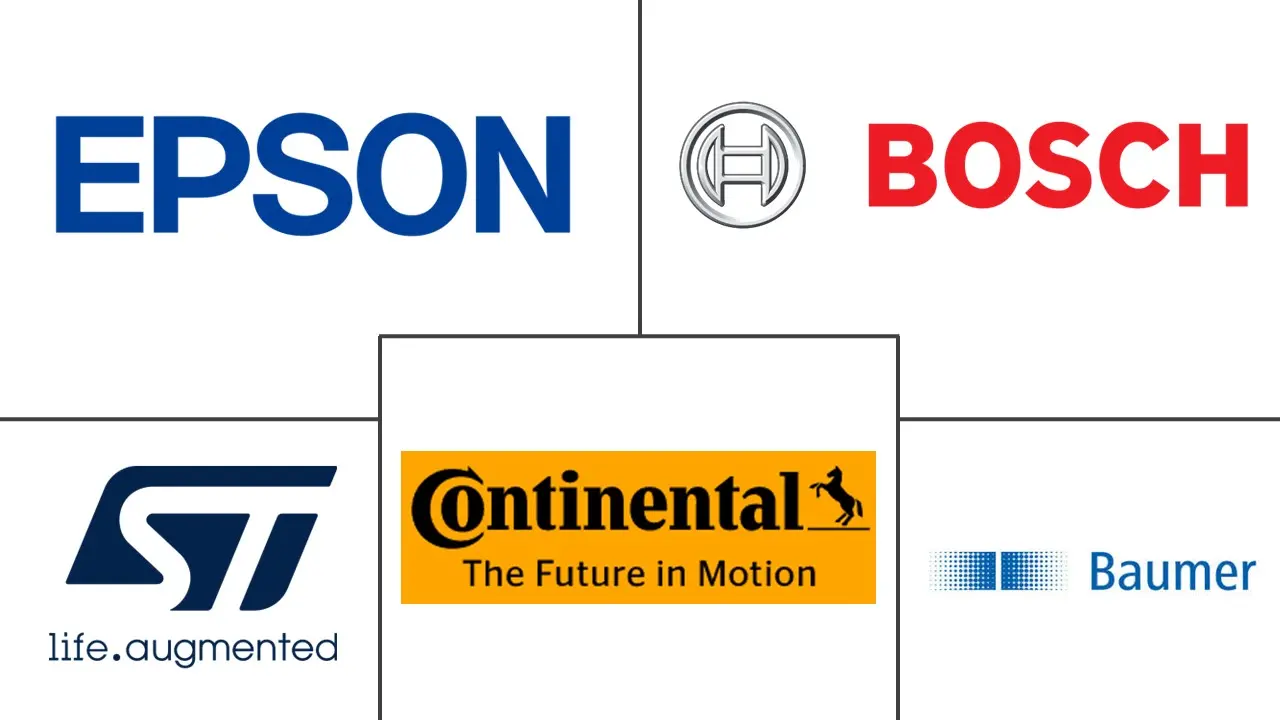Acceleration And Yaw Rate Sensors Market Size and Share
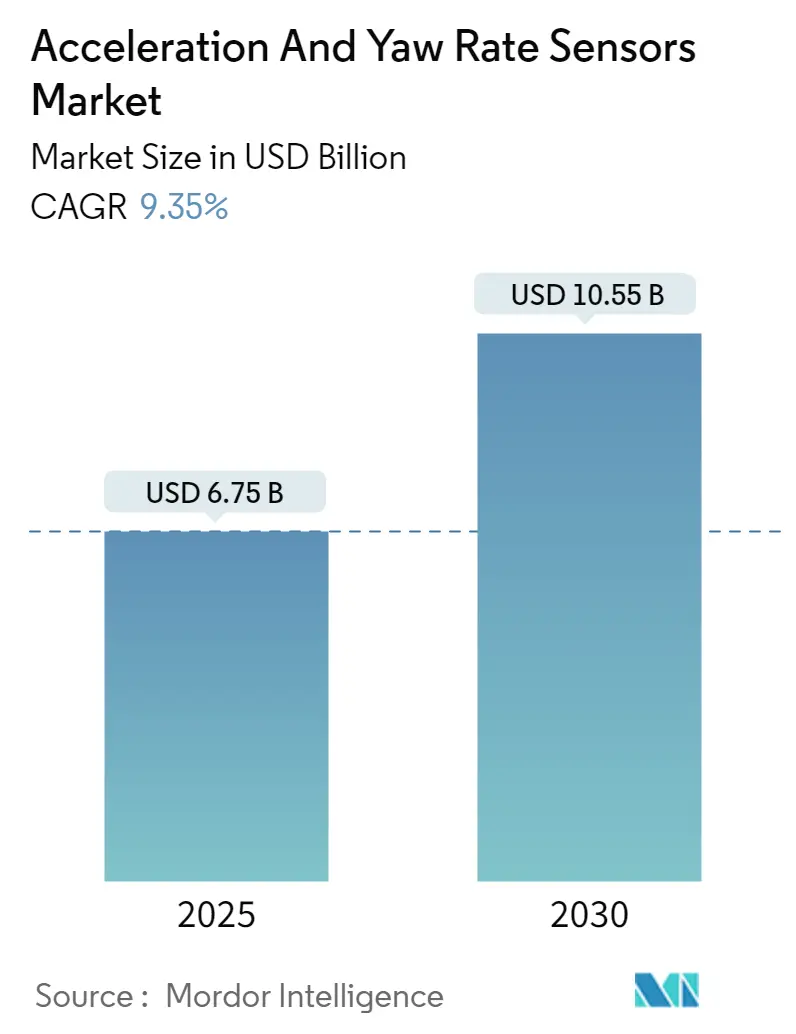
Acceleration And Yaw Rate Sensors Market Analysis by Mordor Intelligence
The Acceleration And Yaw Rate Sensors Market size is estimated at USD 6.75 billion in 2025, and is expected to reach USD 10.55 billion by 2030, at a CAGR of 9.35% during the forecast period (2025-2030).
The automotive industry is undergoing a profound transformation driven by technological advancement and changing consumer preferences. The integration of advanced driver assistance systems (ADAS) and connected vehicle technologies is revolutionizing the driving experience through sophisticated automotive sensor networks and communication systems. This evolution is particularly evident in the passenger vehicle segment, where sales reached significant milestones in 2023, with Asia recording 36.5 million units and North America achieving 18.3 million units. The industry's trajectory is further shaped by stringent safety regulations and the increasing adoption of autonomous driving features.
Manufacturing processes are experiencing substantial shifts with the advent of Industry 4.0 and IoT integration, compelling enterprises to adopt more agile and innovative production approaches. These technological advancements are particularly prominent in China's automotive sector, where manufacturers are leveraging advanced manufacturing techniques to enhance production efficiency and product quality. The Chinese government's ambitious target of reaching 35 million units in automobile output by 2025 exemplifies the scale of industrial transformation underway, with a specific mandate for automakers to produce 40% more electric vehicles than conventional vehicles by 2030.
Major automotive manufacturers are expanding their production capabilities through strategic investments and facility developments. In May 2023, BYD announced plans to establish a new passenger vehicle plant in Europe, while simultaneously planning a vehicle manufacturing facility in Thailand. Similarly, Suzuki Motor Corporation revealed its strategy in October 2023 to achieve sales of 3 million passenger vehicles in India by 2030, accompanied by plans to double its manufacturing capacity to 4 million units over the next decade. These developments reflect the industry's commitment to meeting growing market demands and advancing technological capabilities.
The acceleration and yaw rate sensor ecosystem is witnessing significant advancement in inertial measurement unit technologies and integration capabilities. Manufacturers are focusing on developing smaller, more precise, and cost-effective sensors to meet the growing demand for vehicle stability control and safety systems. The industry is seeing increased collaboration between automotive manufacturers and technology providers to develop innovative solutions. For instance, in June 2023, Sanad and Thales announced their collaboration to enhance air traffic management and advance airport operations in the Middle East and Africa, with Middle Eastern airports projected to invest over USD 150 billion in capacity expansion to accommodate growing air passenger demand through 2040.
Global Acceleration And Yaw Rate Sensors Market Trends and Insights
Surging Consumer Demand for Vehicle Safety, Security, and Comfort
The escalating demand for enhanced vehicle safety, security, and comfort features is fundamentally transforming the automotive landscape. Advanced driver assistance systems (ADAS) and connected vehicle technologies are becoming increasingly prevalent, integrating sophisticated motion sensor networks, cameras, and communication systems to create a more secure and comfortable driving experience. These systems rely heavily on acceleration sensor and yaw rate sensor data to provide critical information for features such as collision avoidance and lane-keeping assistance, reflecting consumers' growing emphasis on safety technology.
The automotive sector has witnessed a significant evolution in safety standards and regulations. For instance, in April 2023, Maruti Suzuki introduced electronic stability control (ESC) as a standard feature across most of its model lineup, from the Celerio to the Grand Vitara. This implementation demonstrates the industry's commitment to enhancing vehicle safety through advanced MEMS sensor technologies. Additionally, Mercedes-Benz vehicles now incorporate advanced features such as adaptive cruise control, lane departure warning, and blind spot monitoring, all of which depend on precise accelerometer and gyroscope data for optimal performance.
Growing Inclination of Consumers Toward Alternative Fuel Vehicles to Reduce GHG Emissions
The automotive industry is experiencing a significant shift toward alternative fuel vehicles, driven by increasing environmental consciousness and the need to reduce greenhouse gas emissions. According to recent data, global greenhouse gas emissions increased by 1.7% in 2022 to reach 53.8 billion metric tons of carbon dioxide equivalent, highlighting the urgent need for sustainable transportation solutions. This trend is reflected in the remarkable growth of electric vehicle adoption, with EV sales in the United States showing nearly 50% growth in the first nine months of 2023, surpassing the full-year total for 2022.
Governments worldwide are actively supporting this transition through various initiatives and policies. For instance, Canada's recent investment in the electric vehicle industry includes a significant project by Northvolt to build a manufacturing facility capable of producing batteries for approximately one million electric vehicles annually by the end of 2026. Similarly, the UAE has launched the 'Global EV Market' project, aiming to increase the share of EVs to 50% of total vehicles on UAE roads by 2050. These initiatives are complemented by investment in charging infrastructure and various incentives, including tax credits and purchase subsidies, making alternative fuel vehicles increasingly attractive to consumers.
Segment Analysis: By Type
Micromechanical Segment in Acceleration and Yaw Rate Sensors Market
The micromechanical type segment dominates the acceleration and yaw rate sensors market, holding approximately 64% market share in 2024. This significant market position is attributed to the segment's widespread adoption in automotive applications, particularly in electronic stability control systems and advanced driver assistance systems (ADAS). MEMS accelerometers are designed to deliver high performance in a small footprint at a relatively low cost, making them suitable for a wide range of applications, from ultra-low power wearables to high bandwidth condition monitoring. The automotive industry has particularly embraced MEMS sensors to increase vehicle reliability, lower costs, and improve performance, with these sensors being installed in hundreds of millions of vehicles. The micromechanical capacitive accelerometer's ability to be used for active suspension control, airbag deployment, active steering, and anti-lock braking systems has further solidified its market dominance. Additionally, accelerometer and gyroscope sensors play a crucial role in enhancing vehicle safety and performance.
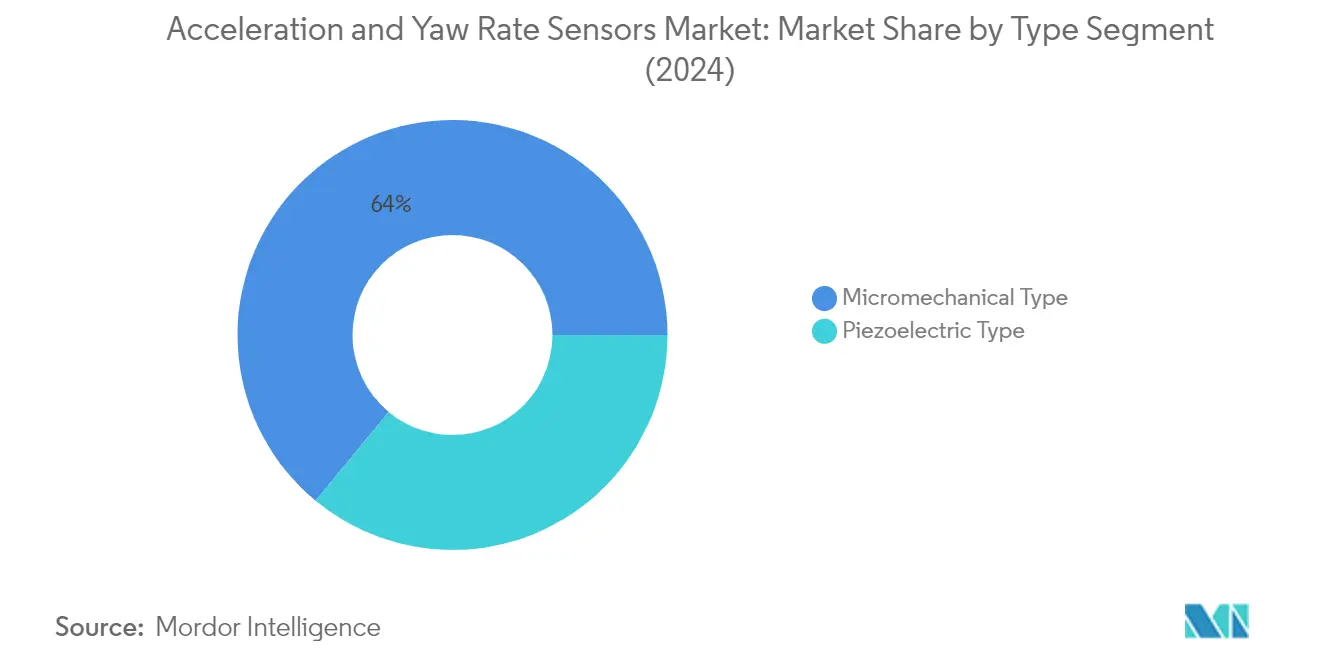
Piezoelectric Segment in Acceleration and Yaw Rate Sensors Market
The piezoelectric type segment is projected to experience the highest growth rate in the acceleration and yaw rate sensors market from 2024 to 2029, with an estimated CAGR of approximately 10%. This impressive growth trajectory is driven by the segment's unique capabilities in operating independently of external power and providing integrated acceleration signals for velocity and displacement measurements. Piezoelectric accelerometers are gaining significant traction due to their wide range of frequencies, low output noise, and linearity in the dynamic range. Their intrinsic ruggedness and thermal stability enable reliable operation in harsh environments with extreme temperatures, making them increasingly popular in aerospace and automotive applications. The segment's growth is further supported by continuous innovations in piezoelectric sensor technology, with manufacturers focusing on developing more sophisticated and efficient solutions for emerging applications in various industries. The integration of yaw rate and acceleration sensor technology is pivotal in expanding the piezoelectric segment's capabilities.
Segment Analysis: By Application
Automotive Segment in Acceleration and Yaw Rate Sensors Market
The automotive segment dominates the global acceleration and yaw rate sensors market, commanding approximately 77% market share in 2024. This significant market presence is driven by the increasing integration of advanced driver assistance systems (ADAS) and electronic stability control systems in modern vehicles. The segment's dominance is further reinforced by stringent safety regulations worldwide and the growing consumer demand for vehicles equipped with sophisticated safety features. The automotive sector's adoption of these sensors spans across passenger cars, light commercial vehicles, and heavy commercial vehicles, with applications ranging from airbag deployment systems to active suspension control. The rapid growth in electric vehicle production and the increasing focus on autonomous driving technologies have created additional demand for these sensors, as they are crucial components in ensuring vehicle stability and control. Major automotive manufacturers are increasingly incorporating these sensors into their vehicle designs, particularly in premium and mid-range vehicles, to enhance safety features and comply with regulatory requirements. The use of inertial sensor and rotational sensor technologies is essential in advancing automotive safety and performance.
Aerospace Segment in Acceleration and Yaw Rate Sensors Market
The aerospace segment represents a crucial application area in the acceleration and yaw rate sensors market, playing a vital role in ensuring flight safety and stability. These sensors are essential components in aircraft navigation systems, flight control systems, and stability monitoring equipment. The aerospace sector's demand for these sensors is driven by the increasing focus on flight safety, the growing commercial aviation sector, and the rising adoption of unmanned aerial vehicles (UAVs). The integration of these sensors in modern aircraft helps in monitoring and controlling aircraft movement across all three axes, ensuring precise navigation and stability during flight operations. Additionally, the increasing investments in aerospace research and development, coupled with the growing demand for more sophisticated aviation technologies, continue to drive innovation in sensor technology for aerospace applications. The inclusion of angular rate sensor and orientation sensor technologies enhances the precision and reliability of aerospace systems.
Acceleration And Yaw Rate Sensors Market Geography Segment Analysis
Acceleration and Yaw Rate Sensors Market in North America
The North American acceleration and yaw rate sensors market maintains a significant presence globally, commanding approximately 22% of the market share in 2024. The region's market is primarily driven by its robust automotive manufacturing sector and advanced aerospace industry. The United States leads the regional market with its extensive network of automotive manufacturers and technological innovation centers. The presence of major automotive companies and their continuous investment in research and development of advanced driver assistance systems (ADAS) and autonomous vehicles significantly contributes to market growth. The region's strong focus on vehicle safety regulations and increasing consumer demand for advanced safety features in vehicles further propels market expansion. Additionally, the aerospace sector's growing requirements for precise motion sensors and stability control systems create substantial opportunities for acceleration and yaw rate sensor manufacturers. The integration of these sensors in commercial and military aircraft applications, coupled with ongoing technological advancements in sensor accuracy and reliability, continues to drive market development in North America.
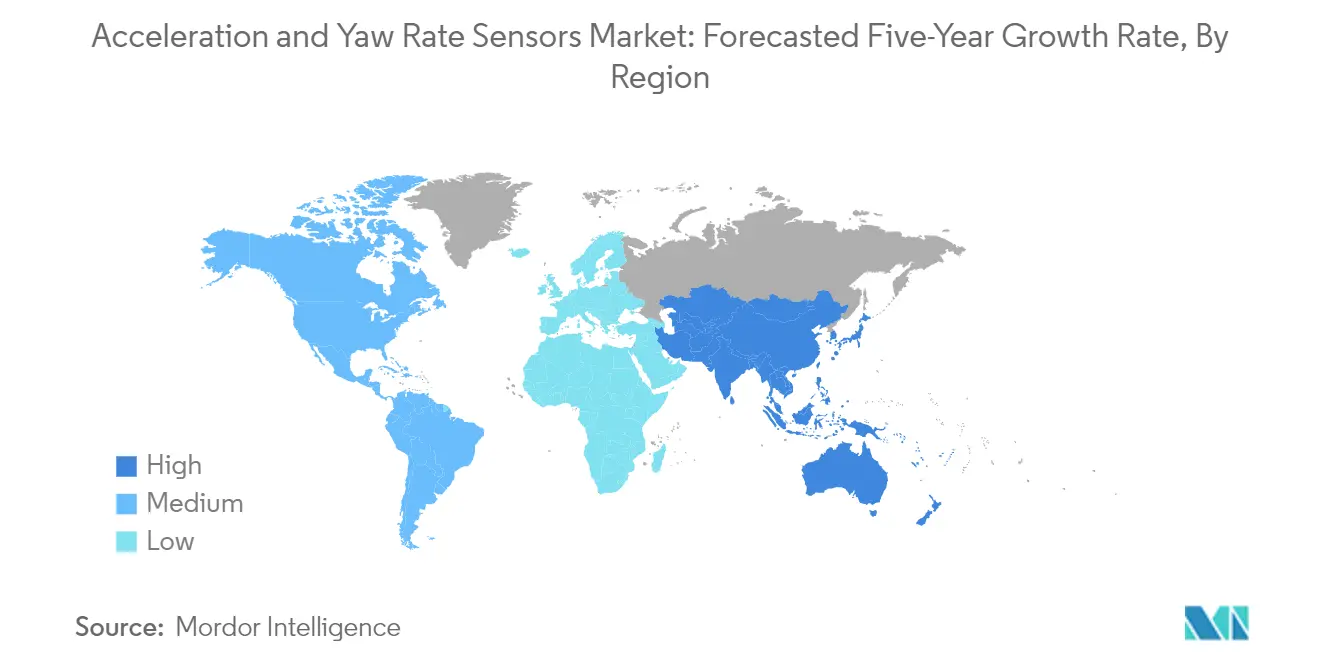
Acceleration and Yaw Rate Sensors Market in Europe
The European acceleration and yaw rate sensors market has demonstrated robust growth, with an estimated growth rate of around 7% during the period 2019-2024. The region's market is characterized by its strong automotive manufacturing base and stringent vehicle safety regulations. Germany, being a major automotive hub, leads the regional market with its advanced manufacturing capabilities and presence of prominent automotive sensors manufacturers. The region's focus on electric vehicle development and autonomous driving technologies has created significant opportunities for sensor manufacturers. The presence of established aerospace manufacturers and their increasing adoption of advanced sensing technologies further strengthens the market position. The European market also benefits from substantial investments in research and development, particularly in improving sensor accuracy and reliability. The region's emphasis on technological innovation, coupled with its strong industrial base and regulatory framework supporting vehicle safety, continues to drive the adoption of acceleration and yaw rate sensors across various applications.
Acceleration and Yaw Rate Sensors Market in Asia-Pacific
The Asia-Pacific acceleration and yaw rate sensors market is positioned for exceptional growth, with a projected growth rate of approximately 10% during the period 2024-2029. The region represents the largest and most dynamic market for these sensors, driven by rapid industrialization and expanding automotive production capabilities. China leads the regional market with its massive automotive manufacturing sector and growing emphasis on electric vehicles. The region's market is characterized by increasing investments in automotive safety technologies and the rising adoption of ADAS features in vehicles. The presence of major automotive manufacturers and their focus on incorporating advanced safety features in vehicles continues to drive market growth. Furthermore, the region's aerospace sector development and increasing defense modernization programs create additional demand for high-precision gyroscopic sensors. The market also benefits from the growing consumer awareness regarding vehicle safety features and the increasing adoption of electric vehicles across major economies like China, Japan, and India.
Acceleration and Yaw Rate Sensors Market in Latin America
The Latin American acceleration and yaw rate sensors market demonstrates steady development, primarily driven by the growing automotive sector in countries like Brazil and Mexico. The region's market is characterized by increasing investments in automotive manufacturing capabilities and rising consumer demand for vehicles equipped with advanced safety features. The adoption of electric vehicles and the implementation of stringent safety regulations are creating new opportunities for IMU sensor manufacturers. The region's automotive industry is experiencing a transformation with the introduction of advanced driver assistance systems and safety features, driving the demand for acceleration and yaw rate sensors. The market also benefits from increasing investments in aerospace and defense sectors, particularly in Brazil. The growing focus on vehicle modernization and safety improvements across the region's commercial vehicle segment further contributes to market expansion. Additionally, the presence of international automotive manufacturers and their localization strategies are helping to strengthen the regional market structure.
Acceleration and Yaw Rate Sensors Market in Middle East & Africa
The Middle East & Africa acceleration and yaw rate sensors market is emerging as a promising growth region, driven by increasing investments in automotive manufacturing and aerospace sectors. The market is characterized by growing demand for vehicles equipped with advanced safety features, particularly in countries like Turkey and South Africa. The region's focus on developing its automotive manufacturing capabilities and increasing adoption of electric vehicles creates new opportunities for sensor manufacturers. The aerospace sector's growth, particularly in the Middle East, drives additional demand for high-precision navigation sensors. The market benefits from increasing investments in vehicle safety technologies and the growing presence of international automotive manufacturers. The region's commitment to modernizing its transportation infrastructure and improving vehicle safety standards further supports market growth. Additionally, the increasing focus on defense modernization programs and the growing aviation sector contribute to the expanding application scope of acceleration and yaw rate sensors in the region.
Competitive Landscape
Top Companies in Acceleration and Yaw Rate Sensors Market
The acceleration and yaw rate sensors market is characterized by the strong presence of established players like Bosch, Continental AG, STMicroelectronics, Epson, and Baumer Group, who have demonstrated consistent innovation in sensor technologies. These companies are focusing on developing advanced MEMS sensor-based technologies with enhanced precision and reliability while simultaneously reducing power consumption and form factors. The industry witnesses regular product launches incorporating features like improved gyroscopic performance, multi-axis measurement capabilities, and integration with emerging technologies like AI and IoT. Companies are strengthening their positions through strategic partnerships with automotive manufacturers and expanding their manufacturing footprint across key regions. There is also a notable trend toward developing customized solutions for specific applications while maintaining standardized interfaces for broader market compatibility.
Global Leaders Dominate Through Technical Excellence
The market structure reveals a relatively consolidated landscape dominated by large multinational corporations with extensive R&D capabilities and established relationships with major automotive and aerospace manufacturers. These companies typically operate as part of larger conglomerates, leveraging their parent companies' resources and distribution networks to maintain market leadership. The competitive environment is characterized by high entry barriers due to the technical complexity of sensor development and the stringent quality requirements of end-user industries. While some regional players maintain strong positions in specific geographic markets, their influence remains limited compared to global leaders.
The industry has witnessed strategic acquisitions aimed at expanding technological capabilities and market reach, particularly in emerging applications like autonomous vehicles and industrial automation. Companies are increasingly focusing on vertical integration to maintain control over critical components and manufacturing processes. The market also sees collaboration between sensor manufacturers and technology companies to develop integrated solutions that combine hardware expertise with software capabilities. This trend is particularly evident in the development of next-generation sensors for advanced driver assistance systems and autonomous vehicles, including the use of inertial measurement unit technologies.
Innovation and Integration Drive Market Success
For established players to maintain and expand their market share, a multi-faceted approach combining technological leadership with market responsiveness is essential. This includes continuous investment in research and development to improve sensor performance, reliability, and cost-effectiveness. Companies must also focus on developing comprehensive solution portfolios that address emerging applications while maintaining strong relationships with key customers in traditional markets. Success increasingly depends on the ability to provide integrated solutions that combine sensor hardware with sophisticated signal processing and analysis capabilities.
New entrants and challenger companies can gain ground by focusing on specialized market segments or emerging applications where established players may have less presence. This includes developing innovative solutions for specific industry verticals or geographic markets with unique requirements. Companies must also consider the increasing importance of regulatory compliance, particularly in automotive and aerospace applications, where safety standards continue to evolve. The ability to navigate complex certification processes while maintaining competitive pricing will be crucial for long-term success. Additionally, developing strong partnerships with system integrators and end-users can help companies establish market presence and build credibility in competitive segments. The motion sensor industry is also seeing advancements in angular velocity sensor technologies, which are crucial for precise measurement and control.
Acceleration And Yaw Rate Sensors Industry Leaders
-
Epson Europe Electronics Gmbh (Seiko Epson Corporation)
-
Bosch Sensortec Gmbh (Robert Bosch Gmbh)
-
STMicroelectronics NV
-
Continental AG
-
Baumer Group
- *Disclaimer: Major Players sorted in no particular order
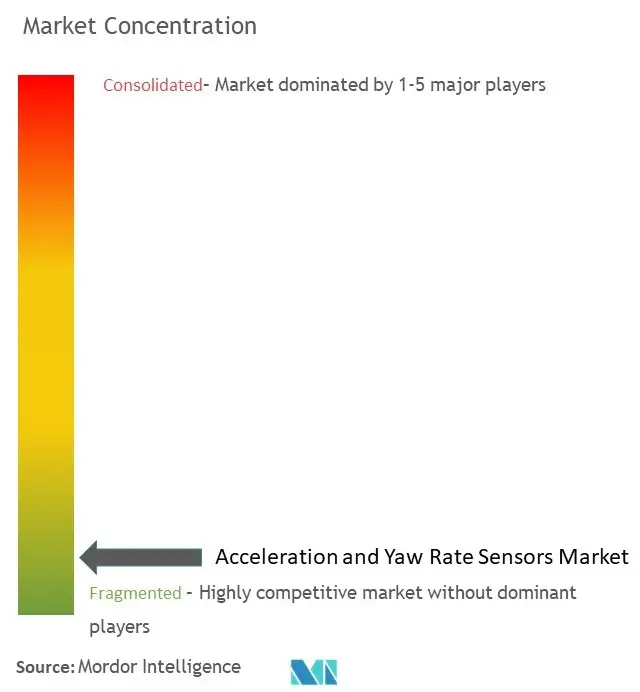
Recent Industry Developments
- June 2023 - AVL is investing over EUR 50 million (INR 412 crore or USD 54.75 million) in testing and validating new semiconductor chips, sensors, and power electronics for battery-powered and software-defined vehicles as part of the EU-approved Important Project of Common European Interest (IPCEI) ME/CT. Among other things, the focus is on cybersecurity. To develop and manufacture more energy-efficient and reliable microelectronics components and communication systems for sustainable and digital mobility in Europe is one of the goals supported by the EU Commission through the IPCEI ME/CT, which has just been approved and is funded by the participating member states with a total of EUR 8.1 billion (INR 66,800 crore or USD 8.87 billion). Up to EUR 175 million (USD 191.61 million) will be made available in Austria, a considerable portion of which will go to AVL.
- February 2023 - NevadaNano, an innovator in environmental, social, and governance (ESG) solutions, announced that it had closed its Series C funding round. First-time investors Honeywell Ventures and Emerson Ventures led the round, joined by several existing investors. NevadaNano is known internationally for designing and manufacturing hardware-enabled SaaS solutions and sensor technologies that detect methane, hydrogen, and flammable gas emissions. NevadaNano is one of the providers of greenhouse gas reduction across numerous industries. The Series C investment will extend NevadaNano’s suite of sensors and expand its line of emissions-tracking products, including MethaneTrack, GHGTrack, and RefrigerantTrack.
Global Acceleration And Yaw Rate Sensors Market Report Scope
A yaw rate sensor is a gyroscopic device that measures a vehicle's yaw rate and its angular velocity on the vertical axis of the vehicle it is attached to. The yaw rate sensor regulates whether the car is developing a propensity to spin around the vertical axis. It assists the ESP control unit in governing the current driving dynamic situation of the car. For this purpose, it is supposed to be placed near the vehicle's center of gravity.
The analysis is based on the market insights captured through secondary research and the primaries. The market also covers the major factors impacting its growth in terms of drivers and restraints. The scope of the acceleration and yaw rate sensors market has been segmented based on type (piezoelectric type and micromechanical type), application (aerospace and automotive [passenger cars, light commercial vehicles, and heavy commercial vehicles]), and geography (North America, Europe, Asia-Pacific, Latin America, and the Middle East and Africa). The market sizes and forecasts are provided in terms of value in USD for all the above segments. The study also tracks the key market parameters, underlying growth influencers, and major vendors operating in the industry, which supports the market estimations and growth rates over the forecast period. The study further analyzes the overall impact of the macroeconomic factors on the ecosystem.
| Piezoelectric Type |
| Micromechanical Type |
| Aerospace | |
| Automotive | Passenger Cars |
| Light Commercial Vehicles | |
| Heavy Commercial Vehicles |
| North America |
| Europe |
| Asia |
| Australia and New Zealand |
| Latin America |
| Middle East and Africa |
| By Type | Piezoelectric Type | |
| Micromechanical Type | ||
| By Application | Aerospace | |
| Automotive | Passenger Cars | |
| Light Commercial Vehicles | ||
| Heavy Commercial Vehicles | ||
| By Geography | North America | |
| Europe | ||
| Asia | ||
| Australia and New Zealand | ||
| Latin America | ||
| Middle East and Africa | ||
Key Questions Answered in the Report
How big is the Acceleration And Yaw Rate Sensors Market?
The Acceleration And Yaw Rate Sensors Market size is expected to reach USD 6.75 billion in 2025 and grow at a CAGR of 9.35% to reach USD 10.55 billion by 2030.
What is the current Acceleration And Yaw Rate Sensors Market size?
In 2025, the Acceleration And Yaw Rate Sensors Market size is expected to reach USD 6.75 billion.
Who are the key players in Acceleration And Yaw Rate Sensors Market?
Epson Europe Electronics Gmbh (Seiko Epson Corporation), Bosch Sensortec Gmbh (Robert Bosch Gmbh), STMicroelectronics NV, Continental AG and Baumer Group are the major companies operating in the Acceleration And Yaw Rate Sensors Market.
Which is the fastest growing region in Acceleration And Yaw Rate Sensors Market?
Asia Pacific is estimated to grow at the highest CAGR over the forecast period (2025-2030).
Which region has the biggest share in Acceleration And Yaw Rate Sensors Market?
In 2025, the Asia Pacific accounts for the largest market share in Acceleration And Yaw Rate Sensors Market.
What years does this Acceleration And Yaw Rate Sensors Market cover, and what was the market size in 2024?
In 2024, the Acceleration And Yaw Rate Sensors Market size was estimated at USD 6.12 billion. The report covers the Acceleration And Yaw Rate Sensors Market historical market size for years: 2019, 2020, 2021, 2022, 2023 and 2024. The report also forecasts the Acceleration And Yaw Rate Sensors Market size for years: 2025, 2026, 2027, 2028, 2029 and 2030.
Page last updated on:
